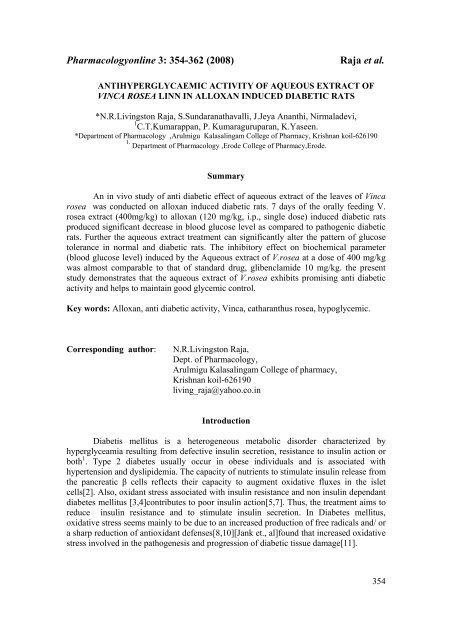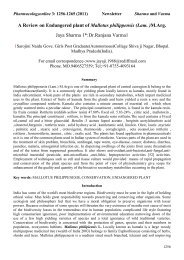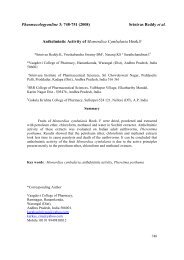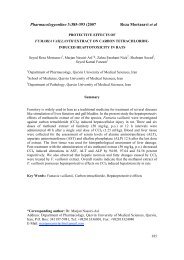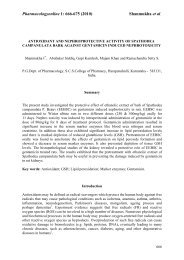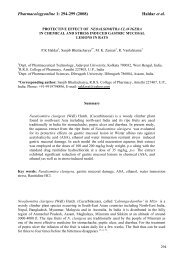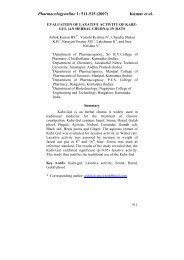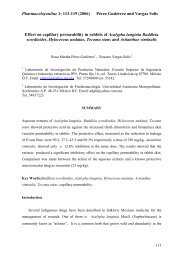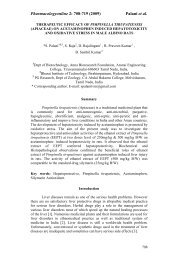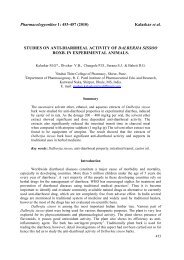Antihyperglycaemic Activity of Aqueous Extract of Vinca Rosea Linn ...
Antihyperglycaemic Activity of Aqueous Extract of Vinca Rosea Linn ...
Antihyperglycaemic Activity of Aqueous Extract of Vinca Rosea Linn ...
You also want an ePaper? Increase the reach of your titles
YUMPU automatically turns print PDFs into web optimized ePapers that Google loves.
Pharmacologyonline 3: 354-362 (2008) Raja et al.<br />
ANTIHYPERGLYCAEMIC ACTIVITY OF AQUEOUS EXTRACT OF<br />
VINCA ROSEA LINN IN ALLOXAN INDUCED DIABETIC RATS<br />
*N.R.Livingston Raja, S.Sundaranathavalli, J.Jeya Ananthi, Nirmaladevi,<br />
1 C.T.Kumarappan, P. Kumaraguruparan, K.Yaseen.<br />
*Department <strong>of</strong> Pharmacology ,Arulmigu Kalasalingam College <strong>of</strong> Pharmacy, Krishnan koil-626190<br />
1. Department <strong>of</strong> Pharmacology ,Erode College <strong>of</strong> Pharmacy,Erode.<br />
Summary<br />
An in vivo study <strong>of</strong> anti diabetic effect <strong>of</strong> aqueous extract <strong>of</strong> the leaves <strong>of</strong> <strong>Vinca</strong><br />
rosea was conducted on alloxan induced diabetic rats. 7 days <strong>of</strong> the orally feeding V.<br />
rosea extract (400mg/kg) to alloxan (120 mg/kg, i.p., single dose) induced diabetic rats<br />
produced significant decrease in blood glucose level as compared to pathogenic diabetic<br />
rats. Further the aqueous extract treatment can significantly alter the pattern <strong>of</strong> glucose<br />
tolerance in normal and diabetic rats. The inhibitory effect on biochemical parameter<br />
(blood glucose level) induced by the <strong>Aqueous</strong> extract <strong>of</strong> V.rosea at a dose <strong>of</strong> 400 mg/kg<br />
was almost comparable to that <strong>of</strong> standard drug, glibenclamide 10 mg/kg. the present<br />
study demonstrates that the aqueous extract <strong>of</strong> V.rosea exhibits promising anti diabetic<br />
activity and helps to maintain good glycemic control.<br />
Key words: Alloxan, anti diabetic activity, <strong>Vinca</strong>, catharanthus rosea, hypoglycemic.<br />
Corresponding author: N.R.Livingston Raja,<br />
Dept. <strong>of</strong> Pharmacology,<br />
Arulmigu Kalasalingam College <strong>of</strong> pharmacy,<br />
Krishnan koil-626190<br />
living_raja@yahoo.co.in<br />
Introduction<br />
Diabetis mellitus is a heterogeneous metabolic disorder characterized by<br />
hyperglyceamia resulting from defective insulin secretion, resistance to insulin action or<br />
both 1 . Type 2 diabetes usually occur in obese individuals and is associated with<br />
hypertension and dyslipidemia. The capacity <strong>of</strong> nutrients to stimulate insulin release from<br />
the pancreatic β cells reflects their capacity to augment oxidative fluxes in the islet<br />
cells[2]. Also, oxidant stress associated with insulin resistance and non insulin dependant<br />
diabetes mellitus [3,4]contributes to poor insulin action[5,7]. Thus, the treatment aims to<br />
reduce insulin resistance and to stimulate insulin secretion. In Diabetes mellitus,<br />
oxidative stress seems mainly to be due to an increased production <strong>of</strong> free radicals and/ or<br />
a sharp reduction <strong>of</strong> antioxidant defenses[8,10][Jank et., al]found that increased oxidative<br />
stress involved in the pathogenesis and progression <strong>of</strong> diabetic tissue damage[11].<br />
354
Pharmacologyonline 3: 354-362 (2008) Raja et al.<br />
Further, there is evidence that diabetes induced changes in the activities <strong>of</strong><br />
antioxidant enzymes in various tissues[12]. Herbal medicines have been used for the<br />
treatment <strong>of</strong> diabetic patients since long and they are currently accepted as an alternative<br />
therapy for diabetic treatment.[13-15].Oral hypoglycemic agents are useful in the<br />
treatment <strong>of</strong> diabetes mellitus but their use is restricted by their pharmacokinetic<br />
properties, secondary failure rates and accompanying side effects and the world health<br />
organization expert committee on diabetes has listed as one <strong>of</strong> its recommendations that<br />
traditional methods <strong>of</strong> treatment for diabetes should be investigated.[16 ]<br />
The plant vinca rosea (= catharanthus roseas, catharanthus, periwinkle ) is a<br />
dicotyledonous plant blonging to the family apocynaceae.This plant is cultivated in south<br />
India ,USA , Europe, Australia and west India as an ornamental plant as well as for its<br />
medicinal properties. It was used as antidysentric, anti hemorrhagic ,diuretic and for<br />
wound healing in European countries .Traditionally in Brazil it was used to treat tooth<br />
ache and in Jamaica it was used to treat diabetes in the form <strong>of</strong> tea. <strong>Vinca</strong> is a erect,<br />
Pubescent herb with branched tap root. Leaves are simple, Petiolate ,Ovate,entire with<br />
acute apex and glossy appearance. The Phytochemical studies reveals the presence <strong>of</strong><br />
about 20 dimeric indoledinydroindole alkaloids.Among them vincristine & Vinblastine<br />
are most significant .Other are ajmalicine ,Lochnerine,serpentine,tetrahydroalstonine[17].<br />
Materials and Methods<br />
Plant Material<br />
The fresh leaves <strong>of</strong> V.<strong>Rosea</strong> were collected from<br />
Srivilliputtur,Tamilnadu,India. The plant was authenticated by Dr.Stephen ,dept <strong>of</strong><br />
botany American college ,madurai. The dried and coarsely powdered drug (100 gm) was<br />
packed in a soxhlet apparatus and was subjected to extraction with water over 72hrs .The<br />
filtrate was evaporates under vaccum drier and brown mass residue obtained was stored<br />
at 4ºC for further use.The average yield <strong>of</strong> the aqueous extract was<br />
approximately37gm.For Experimental study ,The weighed amount <strong>of</strong> aqueous extract<br />
(400 mg/kg) was dissolved in 1% tween80 in normal saline.<br />
Animals<br />
The experimental protocol was approved by the Institutional Animal Ethics<br />
Committee(IAEC) <strong>of</strong> kalasalingam college <strong>of</strong> pharmacy, Srivilliputtur which is registered<br />
with CPCSEA, Government <strong>of</strong> India.(Reg No:509/01/C/CPCSEA).Albino rats <strong>of</strong> either<br />
sex,weighing between 150-200 gms were procured from the central animal House,<br />
Kalasalingam College <strong>of</strong> Pharmacy and acclimatized under standard laboratory<br />
conditions at c2ºC, 50± 15 % RH and Normal photoperiod 12:12 hr eight:dark cycle for 7<br />
days were used Commercial pellet diet and water were provided ad libitum.<br />
Hypoglycemic activity ,Screening in Normal rats<br />
Normal fasted rats<br />
Normal albino rats were first for the screening <strong>of</strong> antidiabetic activity <strong>of</strong> the<br />
aqueous extract <strong>of</strong> V.<strong>Rosea</strong>. Overnight fasted normal rats were randomly divided into 4<br />
groups <strong>of</strong> 5 rats each. The group I served as control ,which received 5% Tween 80 orally,<br />
Group II received glibenclamide 10 mg/kg and 400mg/kg <strong>of</strong> aqueous extract <strong>of</strong> V.<strong>Rosea</strong><br />
respectively. Blood samples were Collected from retro-orbital plexus, before and 1,2 and<br />
355
Pharmacologyonline 3: 354-362 (2008) Raja et al.<br />
4 hr after treatment fasting Blood glucose (FBG) was determined by using commercial<br />
kit .<br />
Glucose Tolerance in normal rats 20<br />
For GTT, overnight fasted rats were divided into three groups <strong>of</strong> 5 rat each.<br />
Group I served as control ,which required 5 % tween 80 orally .Group II received<br />
glibenclamide 10 mg/kg orally. Group III received 400 mg /kg <strong>of</strong> aqueous extract <strong>of</strong><br />
V.<strong>Rosea</strong> orally.<br />
After 30 minutes 3 gm/kg <strong>of</strong> glucose was orally administered to each rat. Blood samples<br />
were collected from retro-orbital plexus just before drug administration and at 0.5,1.5<br />
and 2.5 hrs(after glucose administration) for determination <strong>of</strong> glucose.<br />
Experimental Induction <strong>of</strong> Diabetes<br />
Diabetes was induced by single intraperitoneal injection (120<br />
mg/kg bodyweight) <strong>of</strong> alloxan to overnight fasted rats.After injection rats had free access<br />
to food and water and were given 5 % glucose solution to drink overnight to counter<br />
hypoglycemic shock.Diabtes in rats were confirmed by moderate polydipsia and marked<br />
polyurea.After 3 days the fasting blood glucose levels were determined by ortho-toluidine<br />
method[21].The Rats showing fasting bloodglucose more than 180mg/dl were considered<br />
diabetic and selected for the experiment. 25 rats were randomly divided into 5 groups <strong>of</strong><br />
5 animals each and treated as follows:-<br />
GroupI:- Normal Control, Group II: Diabetic Control alloxan administrated rats.Group<br />
I and II rats received (% tween 80 in normal saline orally once a day for 7 days Group<br />
III – Glibenclamide treated: Diabetic rats received Glibenclamide(10 mg/kg) orally for 7<br />
Days.Group IV :-V.R 400 Treated:Diabetic rats received aqueous extract <strong>of</strong><br />
V.<strong>Rosea</strong>(400 mg/kg) orally for 7 days.The Experiment was terminated at the end <strong>of</strong> 7<br />
days and the animals were fasted overnight.<br />
Biochemical Analysis<br />
Blood Samples were collected from retro-Orbital plexus using micro –Capillary<br />
technique ,From all the groups <strong>of</strong> overnight fasted rats .Whole blood was collected for the<br />
estimation <strong>of</strong> blood glucose[22]<br />
Statistical Analysis<br />
Data’s were expressed as mean ± SEM and subjected to statistical analysis and<br />
glibenclamide treated groups were compared with the normal group P
Pharmacologyonline 3: 354-362 (2008) Raja et al.<br />
Hours. The pretreatment with aqueous extract at V.<strong>Rosea</strong> (400 ,g/kg) and<br />
glibenclamide(10 mg/kg) elicited decreased plasma glucose level significantly(P,0.02) as<br />
compared to the normal control group. The maximum reduction for glibenclamide treated<br />
group was from 184(at 30 mts) to 97 mg/dl(at-2½ hrs) whereas for 400 mg <strong>of</strong> aqueous<br />
extract it was from 194 mg/dl (at 30 mts) to 106.88 mg/dl(at 2½hrs).<br />
Antidiabetic activity screening in experimentally induced diabetic rats<br />
By 7 th day the blood Glucose was increased in untreated diabetic group from 204<br />
± 10.8 to 368 ± 10.2 mg/dl .When compared to 108 ± 6.25 mg/dl in the healthy control<br />
Supplementation <strong>of</strong> aqueous extract <strong>of</strong> V.<strong>Rosea</strong> for 7 days decrease the blood glucose<br />
significantly P
Pharmacologyonline 3: 354-362 (2008) Raja et al.<br />
TABLE 3<br />
EFFECT OF VINCA ROSEA [LINN] LEAVES EXTRACT ON BLOOD<br />
GLUCOSE LEVELES IN ALLOXAN INDUCED DIABETIC RAT<br />
GROUPS FASTING<br />
BLOOD GLUCOSE LEVEL Mg/dl(Mean ±SEM)<br />
1<br />
[DAYS] AFTER TREATMENT<br />
3 7<br />
Control 102.43± 6.24 107.81±3.45 103.61±8.13 108.25±6.25<br />
Diabetic 206.02±10.89 207.63±7.52 207.92±9.84 209.48±8.47<br />
Diabetic with<br />
glibenclamide<br />
10 mg/kg<br />
Diabetic with<br />
test <strong>Extract</strong> 400<br />
mg/kg<br />
205.23±12.45 191.80±11.23* 183.84±9.65* 174.58±11.24*<br />
204.37±8.34 194.45±7.28* 173.51±12.34* 169.46±11.42*<br />
Data are expressed as the mean ±SEM(n=6) in each group<br />
When compared to control and treated group by student’s “t” test<br />
*P
Pharmacologyonline 3: 354-362 (2008) Raja et al.<br />
FIG-2 EFFECT OF VINCA ROSEA [LINN] LEAVES EXTRACT ON ORAL<br />
GLUCOSE TOLERANCW IN NORMAL RAT<br />
FIG-3 EFFECT OF VINCA ROSEA [LINN] LEAVES EXTRACT ON BLOOD<br />
GLUCOSE LEVELS IN ALLOXAN INDUCED DIABETIC RAT<br />
359
Pharmacologyonline 3: 354-362 (2008) Raja et al.<br />
Discussion<br />
In the present Experiments, the aqueous extract like glibenclamide, showed<br />
hypoglycemic effect at 400 mg/kg in both normal and Glucose loaded normal fasted<br />
rats..It is to be studied that the extract brought about these changes by acting through<br />
pancreatic mechanism similar to that <strong>of</strong> glibenclamide[23] or by inhibition <strong>of</strong> glucose<br />
absorption through gastrointestinal tract other herbs(P.marsupium and M.Charantia)<br />
[24,25]. The hypoglycemic effect <strong>of</strong> aqueous extract <strong>of</strong> V.<strong>Rosea</strong> (in Normal Rats) at 400<br />
mg/kg was 72.46 and it was comparable to that <strong>of</strong> glibenclamide 58.64.<br />
The glucose tolerance test in normal rats showed that the pretreatment with<br />
aqueous extract <strong>of</strong> V.<strong>Rosea</strong> (400 mg/kg) and glibenclamide (10 mg/kg) elicited decreased<br />
plasma glucose level significantly(P
Pharmacologyonline 3: 354-362 (2008) Raja et al.<br />
6. Faure P , Rossini E, Lafond JL, Vitamin E improves the free radical defense<br />
system potential and insulin sensitivity <strong>of</strong> rats fed high fructose diet, J Nutr.,<br />
127(1997)103.<br />
7. Reedich M. Kozlovsky N, Potashnix R, oxidant stress reduces insulin<br />
responsiveness in 373-L adipocytes, AM J Physiol, 272 (1997) E935.<br />
8. Cross CE, Halliwell B, Oxygen radicals and human disease, Ann Intern Med, 107<br />
(1987) 526.<br />
9. Giugliano D, Ceriello A, Oxidative stress and diabetic vascular complications,<br />
Diabetic care, 19 (1996) 257.<br />
10. Low PA, Nickander KK, The roles <strong>of</strong> oxidative stress and antioxidant treatment in<br />
experimental diabetic neuropathy Diabetes, 46, (1997) S 38.<br />
11. Jang YY, Song JH, Shin YK, Protective effect <strong>of</strong> boldine on oxidative<br />
mitochondrial damage in streptozoto in-induced diabetic rats, pharmacological<br />
Res, 42 (2000) 361.<br />
12. Oberley LW, Free radicals and diabetes, Free Radical Biol Med, 5, (1988) 113.<br />
13. Battua GR, Mamidipalli 8N, Parimia R, Hypoglycemic and Antihyperglycemic<br />
effect <strong>of</strong> alcoholic extract <strong>of</strong> Benincasa hispida in Normal and in alloxan induced<br />
Diabetic rats, Pharmacog Mag, 3(2007).<br />
14. Modak M, Dixit P, Londhe J, Indian Herbs and Herbal drugs used for the<br />
treatment <strong>of</strong> Diabetes, J Clin Biochem Nutr, 40(2007)163.<br />
15. BaddeS, Patel N, Bodhankar S, Antihyperglycemic activity <strong>of</strong> aqueous extract <strong>of</strong><br />
leaves <strong>of</strong> cocculus hirsutus (L) Diets in alloxan induced Diabetic mice, Indian<br />
J.Pharmacol, 38(2006) 49.<br />
16. Naggar EM, Antidiabetic effect <strong>of</strong> Cleome droserifolia aerial parts: Lipid<br />
peroxidation-induced oxidative stress in diabetic rats, Acta Vet, Brno,<br />
74(2005)347.<br />
17. Wealth <strong>of</strong> India – Raw materials vol – II, V revised Edition, 6, 7.<br />
18. Skim F, Kaaya A, Jaouhari JT, Hypoglycemic activity6 <strong>of</strong> Globularia alypum<br />
leaves in rats, Fitoterapia, 70(1999) 382.<br />
19. Sabu MC, Kuttan R, Antidiabetic activity <strong>of</strong> Medicinal plants and its relationship<br />
with their antioxidant property, J Ethnopharmacol, 81(2002)155.<br />
20. Williamson EM, Okpako DT, Diabetes mellitus in pharmacological methods in<br />
phytotherapy research, Wiley and sons publication, England, 1996, 158.<br />
21. Scientific and Research Publication from Indian Drug Manufacturers<br />
Association. Indian Drugs, Vol.,44 No.,8 Aug2007.<br />
22. Hyavarina A, Nikkita E, Specific determination <strong>of</strong> blood glucose with orthotoluidine,<br />
clin chim Acta, 7(1962)140.<br />
23. Best CH, Tayler NB, Physiological basis <strong>of</strong> Medical practice 6 th edn, Williams<br />
and Williams company, Baltimore, 1959, 68.<br />
24. Mukhtar HM, Ansari SH, Ali M, Effect <strong>of</strong> aqueous extract <strong>of</strong> pterocarpus<br />
marsupium wood on alloxan induced diabetic rats, pharmazie, 60(2005)478.<br />
25. Meir P, Yaniv Z, An in vitro study <strong>of</strong> Momordica charantia on glucose uptake<br />
and glucose metabolism in rats , plants medica, 1(1985)12.<br />
26. Lenzen S, Panten U. Alloxan: History and Mechanism <strong>of</strong> action, Diabetologia,<br />
1988, 31, 337-42.<br />
27. Oberley LW, Free radicals and diabetes, Free Rad Biol Med, 1988, 5, 113-24.<br />
361
Pharmacologyonline 3: 354-362 (2008) Raja et al.<br />
28. Jorns A, Munday R, Tiedge M, comparative toxicity <strong>of</strong> alloxan, N-alkyl alloxans,<br />
and ninhydrin to isolated pancreatic islets in vitro, J Endocrinol, 1997, 155, 283-<br />
93.<br />
29. Ledoux SP, Woodley SE, Palton NJ, Mechanism <strong>of</strong> nitrosourea induced Beta<br />
cells damage alterations in DNA, Diabetes, 1986, 35, 866-72.<br />
30. Szicudelsice T, The mechanism <strong>of</strong> alloxan and streptozotocin action in beta cells<br />
<strong>of</strong> the rat pancreas, physiol Res, 200, 50, 537-46.<br />
362


